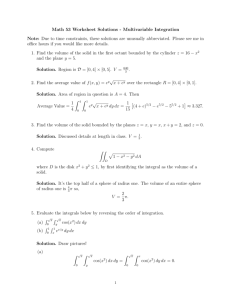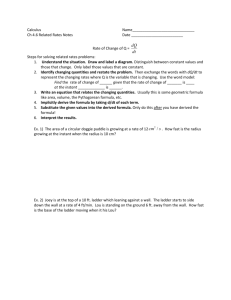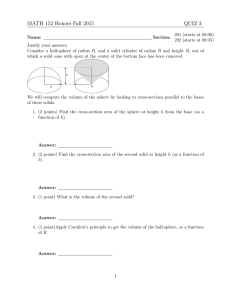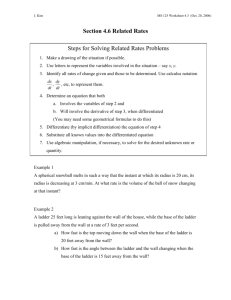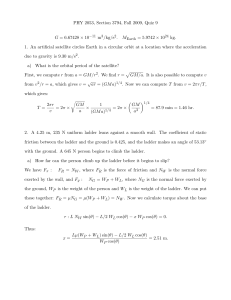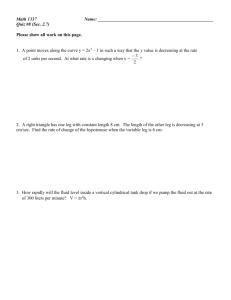MATH 18.01, FALL 2014 – PROBLEM SET #3B
advertisement
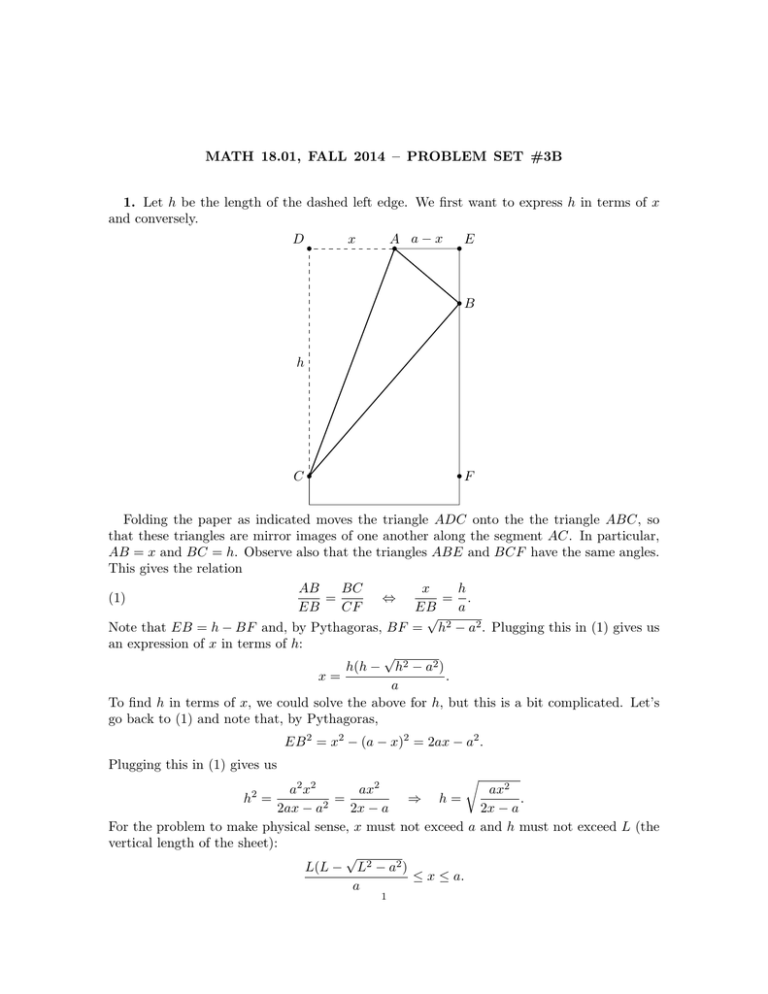
MATH 18.01, FALL 2014 – PROBLEM SET #3B 1. Let h be the length of the dashed left edge. We first want to express h in terms of x and conversely. D x A a−x E B h C F Folding the paper as indicated moves the triangle ADC onto the the triangle ABC, so that these triangles are mirror images of one another along the segment AC. In particular, AB = x and BC = h. Observe also that the triangles ABE and BCF have the same angles. This gives the relation AB BC x h (1) = ⇔ = . EB CF EB a √ Note that EB = h − BF and, by Pythagoras, BF = h2 − a2 . Plugging this in (1) gives us an expression of x in terms of h: √ h(h − h2 − a2 ) x= . a To find h in terms of x, we could solve the above for h, but this is a bit complicated. Let’s go back to (1) and note that, by Pythagoras, EB 2 = x2 − (a − x)2 = 2ax − a2 . Plugging this in (1) gives us r a2 x2 ax2 ax2 ⇒ h = . h = = 2ax − a2 2x − a 2x − a For the problem to make physical sense, x must not exceed a and h must not exceed L (the vertical length of the sheet): √ L(L − L2 − a2 ) ≤ x ≤ a. a 2 1 2 MATH 18.01, FALL 2014 – PROBLEM SET #3B (To explain why the first inequality is in that direction, note (by looking at the picture) that x is a decreasing function of h; an upper bound for h therefore translates into a lower bound for x.) (a) Let S denote the area of the triangle ABC. We have r r 1 ax2 ax4 1 1 1 S = AB · BC = xh = x = . 2 2 2 2x − a 2 2x − a We can observe that S is minimal if and only if S 2 is minimal, so it suffices to minimize S2 = 1 ax4 4 2x − a (passing from S to S 2 is not necessary, but it is easier to compute the derivative without the square root). Let’s compute the derivative, using the quotient rule: 1 4ax3 (2x − a) − 2ax4 1 2ax3 d(S 2 ) = = (3x − 2a) dx 4 (2x − a)2 4 (2x − a)2 The sign of this expression is just the sign of 3x − 2a, since all the other factors are positive. 2) 2 Thus, d(S dx has a zero at x = 3 a, is negative before, and positive after. Let’s check whether x = 23 a is a meaningful value for x: the corresponding h-value is h = √23 a < 2a ≤ L, so it is meaningful. It follows that x = 23 a is the value of x for which S is minimal. (b) Let ` denote the length of the crease AC. By Pythagoras, `2 = x2 + h2 = x2 + ax2 . 2x − a Note that ` is minimal if and only if `2 is minimal, so it suffices to minimize `2 . We have d(`2 ) 2ax(2x − a) − 2ax2 2x2 = 2x + = (4x − 3a). dx (2x − a)2 (2x − a)2 The sign of this expression is the sign of 4x − 3a, since the other factors are positive. Thus, d(`2 )/dx has a zero at x = 43 a, is negative before, and positive after. When x = 43 a, h = √ 3 2 4 a < 2a ≤ L, so 43 a is a physically meaningful value of x, and it is the value of x for which ` is minimal. 2. Let us first compute the surface area S on a sphere of radius r which is visible from a distance d to the center of the sphere. r h d MATH 18.01, FALL 2014 – PROBLEM SET #3B 3 The given formula for the surface area is S = 2πrh. Using elementary geometry, we see that h = r(d − r)/d, so that S = 2πr r(d − r) . d Let x be the distance between the center of the sphere of radius 1 and a point between the two spheres. The distance from the point to the center of the sphere of radius 2 is then 6 − x. Since the point cannot be inside the spheres, we have 1 ≤ x ≤ 4. The surface area visible on the radius 1 sphere is S1 = 2π x−1 , x and the surface area visible on the radius 2 sphere is S2 = 2π · 2 4(4 − x) 2((6 − x) − 2) = 2π . 6−x 6−x The total surface area visible is therefore S = S1 + S2 = 2π x − 1 4(4 − x) + x 6−x . We seek to maximize S. The candidate values of x for a maximum are the endpoints x = 1 and x = 4, and the critical points. Let’s find the critical points: 1 8 dS = 2π − dx x2 (6 − x)2 is zero when 1 x2 = (6 − x)2 ⇔ 8x2 = 36 − 12x + x2 , 8 ⇔ 7x2 + 12x − 36 = 0, √ 6 ⇔ x = (−1 ± 2 2). 7 √ The only critical point between 1 and 4 is x = 76 (2 2 − 1). In the hope of proving that this is a maximum, we compute the second derivative: d2 S 2 16 = 2π − 3 − . dx2 x (6 − x)3 √ 2 As 1 ≤ x ≤ 4, we see that ddxS2 is always negative. The critical point x = 76 (2 2 − 1) is therefore where S is maximal. 3. Let x be the distance from the foot of the ladder to the wall, and let y be the altitude of the top of the ladder. We want to find the relation between x and y. MATH 18.01, FALL 2014 – PROBLEM SET #3B 20 ft 4 y 12ft x p By Pythagoras, the horizontal distance separating the endpoints of the ladder is given by 202 − y 2 . By similar triangles, we deduce the relation p x 202 − y 2 x2 202 − y 2 202 = ⇔ = = − 1. 12 y 122 y2 y2 We can now take the derivative of both sides with respect to time t, using the chain rule: 2x dx 202 dy = −2 122 dt y 3 dt dy 1 dx 5 = − 2 2 xy 3 = − 2 2 xy 3 . dt 12 20 dt 12 20 √ (a) When 5 feet of the ladder project over the wall, one has x = 152 − 122 = 9 and y = 12 15 20 = 16. Therefore, dy/dt = −16/5 (this is negative because y is decreasing). The top of the ladder approaches the ground at 16/5 = 3.2 feet/min. √ (b) When the top of the ladder is at the top of the wall, x = 202 − 122 = 16 and y = 12. Therefore dy/dt = −12/5. The top of the ladder approaches the ground at 12/5 = 2.4 feet/min. 4. (a) The distance travelled by the center is exactly θ, by definition of radians (for instance, after one full revolution, the center will have moved to the left by 2π). Since the wheel is going to the left, we have xcenter = −θ. (b) We have ⇒ (xp , yp ) = (xcenter , ycenter ) + (cos θ, sin θ) = (−θ + cos θ, 1 + sin θ). (c) We simply derive the expressions obtained in (a) and (b): x0center = −θ0 , x0p = −θ0 − θ0 sin θ, yp0 = θ0 cos θ. (d) If p is directly above the center, then cos θ = 0 and sin θ = 1. Thus, x0p = −2θ0 = 2x0center , yp0 = 0. (e) If p is directly below the center, then cos θ = 0 and sin θ = −1. Thus, x0p = 0, yp0 = 0.
